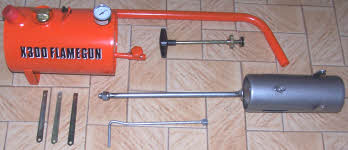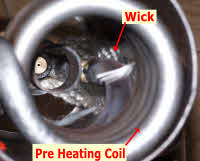

Using a Flame Weeder
* For paths, drives and scree,
Compare Hoeing with Flame WeedingFlame weeders have two advantages over a hoe.
Flame weeders don't however appear to be effective against perennial grass weeds like couch grass. Unlike tap roots these have underground stems carrying leaf buds from which they are able to reshoot. They are most effective at reducing annual weeds that compete with your seedlings or grow in awkward-to-weed places. They are well-used in agriculture on carrots seed beds. Flame Weeding Carrots, Beetroot...Timing is everything when flame weeding a seed bed. Choose a dry day.Because carrots take a long time to germinate rows can be easily overcome by weeds before the carrot seedlings appear. It is important to kill as many weed seedlings as possible. They compete severely with the young carrots. The best method is to flame weed the seed bed just before carrot seedlings show - you might sow a little deeper. Under the surface your seedling leaves should just be sprouting - stay alert - this could be up to 21 days after sowing depending on conditions. The first appearance of carrot seedlings perhaps from a short poly-covered row indicates the rest are about to appear. That's usually a good time to use the flame weeder. You should only need a single, steady, slow pass to leave the weeds beyond recovery. Flame guns can also be used carefully between rows of growing plants. For example, it is vital to keep weeds out of onion beds for the first 6-8 weeks of seedling growth - hood accessories for flame guns are on this link. By avoiding disturbance, fewer weeds may reappear. But it may still be necessary to weed close to seedlings by hand, so that's where the annual weeds will reappear. Avoid using flame weeders close to single stemmed climbing plants like runner beans. They rely on one stem for sap flow and will be most adversely effected by heat damage - hoods are available for weed burners along with trolleys to steady the moving flame. For vegetables such as cabbage or lettuce I recommend sowing seeds in modules or trays and planting out. Sterilizing Soil And CompostSterilization involves spreading out the leaf mold on a ceramic or metal tray or wheel barrow and flaming over. Then I carefully pour the compost through the flame into a container. Briefly the compost will smoke slightly. Weeding Paths, Drives, WallsWhen weeds take hold in paving cracks they may never be pulled out. Weed burners are ideal for this. Heat treating without cutting the plant, saps the strength of these crevice weeds. And on hard landscapes there's usually little chance of damaging anything else.Two Types Of Flame WeederWeed Wand And Gas Cannister This is a simple tube with integral attachment for a small gas canister. Some run off larger gas bottles that rest directly on the ground or in a trolley. These are connected to the wand by a short hose and regulator.Others have a light screw on gas cannister and a pizzo-electric push button ignitor makes starting the job easy. Notice that more advanced weed wands have the tube bent forward near the bottom. This ensures the flame is directed away from your feet. The weed wand is suitable for most ordinary sized gardens. Paraffin Fierce Flame Weeder The X300 is a better tool for flame weeding larger areas e.g. allotments, longer rows, larger seed beds. It is considerably larger than the Weed Wand and produces a fierce flame. This is not for use in confined spaces.It burns liquid paraffin like that used in greenhouse heaters, sometimes known as Parasene. On a cool spring day I found this liquid like water to ignite where it was spilled. But warmth and wicking readily turn the liquid into flammable gas. 
How does the X300 work? A hand pump increases pressure in the tank. The regulator allows fuel down the fuel pipe to the burner. Here it passes through a coil where the paraffin is pre-heated. It emerges at the back of the burner as gas and ignites to provide a fiercely hot flame rather like a flame thrower. Check the operating instructions that are included. Additional Notes On Operating the X300. It's best to avoid a windy day, but in any event remain up-wind of the burner and have plenty of space in front of the burner. Before lighting replace cap on fuel can and remove it to safety. Initially a wick is used to evaporate the fuel in the burner. Take care because once alight the flame can engulf all around it. Once the wick contains enough paraffin to ignite and burn for 3 minutes, close the regulator. Then ignite the wick with a long-stemmed match or lighted taper. 
With the flame burning in the chimney you can leave it for 3 minutes or so with the regulator closed. Take care that excess paraffin doesnt drip out of the back to burn on your side. As the fuel in the pre-heat coil heats up and turns to gas, the flame roars. By this time you should have pumped the pressure up to 20. With a continuous roar sounding out, open the regulator a half turn. Youll have a fierce hot flame. Even a sideways glance is enough to kill plant leaves. To better contain the heat, I recommend purchasing the hood. The trolley accessory takes the weight of the paraffin tank and steadies your aim and distance as you wheel it along.
You'll Find Garden Flame Weeders On Links Below
|

|
-
Flame Weeding equipment is here - can also be used to melt snow and ice
And more Weeding Tools & Solutions For Organic Gardeners.
-
Find
Handy Weed Wands
&
Larger Flame Weeders and tools here
Weeding Burning equipment is here Auto-ignition weed wand, gas canisters and the X300 Flame Gun
Garden Gate
-
Find more pages of information on:
lawn weeds
,
-
annual weeds,
-
reclaiming an overgrown site,
-
how garden weeds thrive,
-
intelligent weed control,
-
rotavators & tillers,
-
natural weed prevention,
-
compare herbicides with organic weed killers,
-
perennial weed control,
-
The Organic Gardener's Tool Shed, &
the best in small handy weeding tools,
My Neighbour's Garden
-
Do you run a gardening website
- with information to interest my visitors?
To set up exchange links from/to
suitable pages - click here.

 >
> 